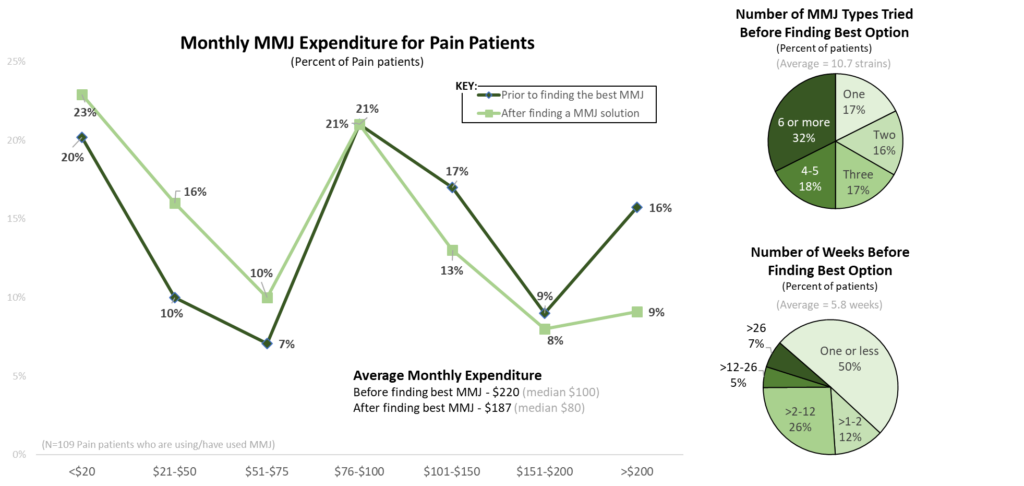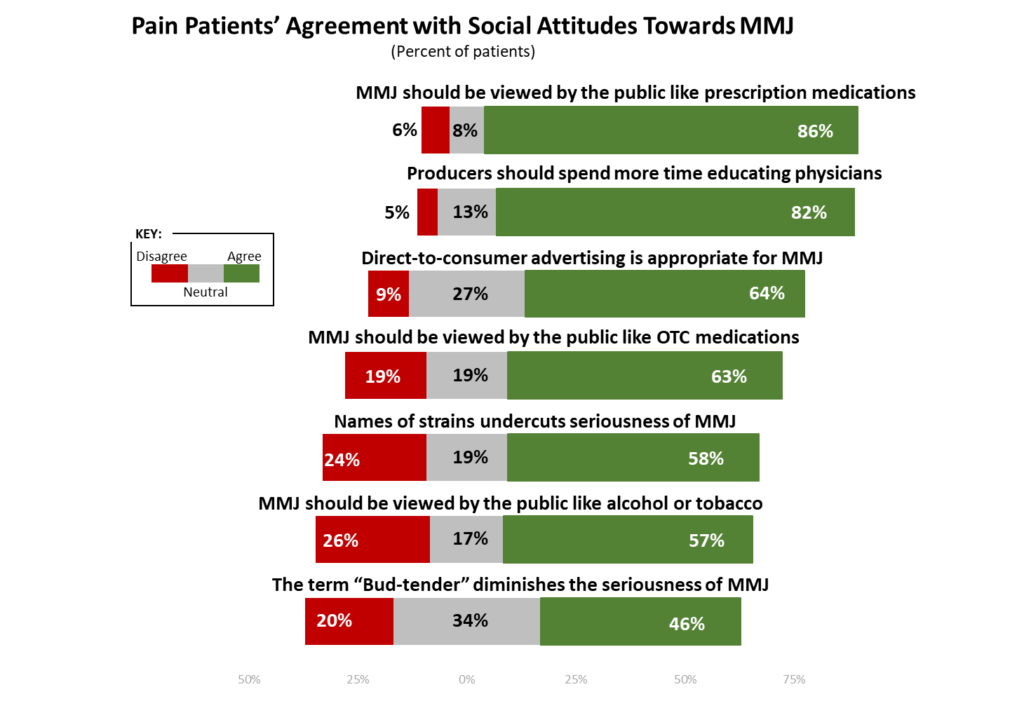Promoting Medical Cannabis Among Pain Patients in the USA
Marijuana Industry NewsMedical Marijuana June 13, 2019 MJ Shareholders 0

John Taenzler, Ph.D.
Of all the potential benefits of medical cannabis being explored, pain relief appears to hold the most immediate promise. A review by the National Institutes of Health (NIH) of the implications of pain on a patient’s life has shown to have serious consequences for the patient, including a severely detrimental effect on their social and family environment and their health care services[i]. For over a century, the most effective treatment for pain has been the administration of opioids. However, with advances creating stronger (and more effective) opioids, their use and risks have increased dramatically over the past few decades. The Centers for Disease Control (CDC) has published an overview, called Understanding the Epidemic[ii]. In highlighting the dangers of this crisis, the CDC outlines that:
- From 1999 to 2017, more than 700,000 people have died from a drug overdose.
- Two-thirds (68%) of the more than 70,200 drug overdose deaths in 2017 involved an opioid.
- In 2017, the number of overdose deaths involving opioids was 6 times higher than in 1999.
- On average, every day, 130 Americans die from an opioid overdose.
In October 2018, a survey was conducted among 172 patients suffering from chronic pain in 16 of the States where medical cannabis has been approved and available [iii]. An objective of this research was to assess the depth of knowledge about cannabis claims, logistics for acquiring/using cannabis, and attitudes of their physicians toward medical cannabis.
In examining and assessing the perceptions and attitudes of these pain patients towards cannabis, each was asked about their current use and, given their current knowledgebase, how likely they are to use cannabis in the future to treat their pain. These questions were used to segment pain patients based on their use.
- Pain patients currently using medical cannabis (n=60)
- Pain patients who used medical cannabis in the past, but not currently (n=48)
- Pain patients who have never used medical cannabis (n=64)
Over half (53%) of these patients are taking opioids to alleviate their pain, with over one-third (36%) taking an opioid every day. An additional one-fourth (27%) take an opioid at least once per week.
Use of Medical Cannabis
Roughly two-thirds (63%) of patients surveyed say they have used (or are using) cannabis to treat their pain, with half (49%) of these patients saying they used medical cannabis daily in attempting to alleviate their pain. However, only half (49%) of these patients began using medical cannabis without first discussing it with their physician(s). Further, only half (49%) of all pain patients have discussed the potential of medical cannabis use with ANY physician. Pain patients say they did not discuss their cannabis use with their physician(s) as they were concerned that their physicians would not approve (57%), or they did not think that medical cannabis was an option (46%).
For the 37% of patients who have never used medical cannabis, only 46% have discussed it with a physician. When asked why they have not used medical cannabis to-date, the most common reason was not wanting to expose their lungs to smoke or vapor (showing a lack of knowledge of other forms of ingestion). Other reasons for not using cannabis are based on not wanting to be impaired (e.g., do not want to feel “high”), and concerns about the risk of legal implications and safety.
When seeking information about medical cannabis, pain patients have turned most often to their physician (most typically their Primary Care Physician (PCP)), to general information cannabis sites (e.g., Leafly©, WeedMaps©, etc.), or to a local dispensary’s website. Overall, these patients say the dispensary pharmacist has been the best source of information and nursing staff and “bud-tenders” have been the worst sources of information. Furthermore, for those who say they turned to a “bud-tender” at a dispensary, most say the information obtained was poor and often biased (e.g., salesperson pushing products rather than seeking details about the patient’s needs).
When actually having a discussion with their physicians about cannabis, very little information is provided. However, patients are told to report any side effects from their use. Only one-fourth (27%) of patients who discussed cannabis with their physician say they were provided information about it. Topics covered most often include[1]:
- Medical benefits of CBD
- Psychoactive properties of THC
- Different methods of ingestion
- How to get a medical cannabis card from the state
Conversely, a number of topics were not discussed by the enquiring patient and their physician, including[2]:
- Interactions of THC-CBD-Terpenes
- Medical benefits of terpenes
- How cannabis is tested
- How much cannabis costs
[1]Topics for which at least 30% of patients who enquire about MMJ have discussed with their physician.
[1]Topics for which fewer than 10% of patients who enquire about MMJ have discussed with their physician.
In addition to lack of basic information about the benefits, risks and logistics about medical cannabis, even if a patient decides to begin using it, they are often frustrated in their struggle to find the strain and/or form of consumption that works best for them. On average, pain patients turning to medical marijuana (MMJ), had tried 10.7 strains over an average of 6 weeks before they found the strain that works. With an average expenditure of $187.00 per month for medical cannabis, these costs can be burdensome for many.
The question is then raised, what can be done to 1) encourage current users to keep using medical cannabis, 2) encourage former users of the benefits of cannabis so that they will consider using it again, and 3) overcome barriers faced by unwilling users.
Pain Patient Profiles
During the survey, pain patients were presented with a list of topics regarding cannabis, and each was asked to rate their familiarity with each topic, specify which topics they have discussed with their physician(s), and indicate which topics would most impact their future use of cannabis. These topics ranged across a number of themes, including:
- Cannabis Pharmacology
- Cannabis Regulations
- Cannabis Logistics
Analysis reveals key distinguishing characteristics among the three segments of pain patients.
Pain patients who are currently using medical cannabisare most familiar with topics surrounding cannabis and are most likely to have spoken with a physician about topics (80% of current users).
The factors that will most encourage current users’ future use of cannabis include (in priority order):
- Better guidance for which strain to use
- Requirements to get/renew a Medical Cannabis Card
- How Terpenes-THCs-CBD interact with each other
- Long-term risk of cannabis
- More specifics on the classification of cannabis
- Cost comparisons for cannabis
Profile: Pain patients who are currently using medical cannabis are the most well-informed about it and are most likely to have spoken to a physician about most of the listed topics regarding cannabis. Although confident about the logistics for medical cannabis, they are looking for better guidance.
Pain patients who used medical marijuana in the past but no longer are using itare more familiar with the pharmacology of cannabis than are non-users (but less familiar than users), and at par with non-users regarding all other cannabis topics. One of the factors that may have stopped their use of medical cannabis is the expense and an inability to find an adequate strain. Former users report an average of $312.00 per month in costs associated with their use of medical cannabis (vs., only $146.00 among current users). Further, 67% of former users (vs., 25% of current users) say they struggled to find a strain that provided adequate pain relief.
The factors that will most influence former users’ future use of MMJ include (in priority order):
- Requirements and logistics for getting a Medical Cannabis Card
- Guidance for which strain to use
- Medical benefits of CBD
- Long-term risks of cannabis
- Costs of medical cannabis
Profile: Pain patients who are former users of MMJ are moderately informed about cannabis, but unlike current users are less familiar with the logistics of obtaining a Medical Cannabis Card and the product itself. These patients have been frustrated in the past finding an adequate medical cannabis solution, and as a result have paid much more out-of-pocket in seeking pain relief.
Pain patients who have never used medical cannabisare the least familiar with various topics about cannabis, and fewer have spoken with a physician regarding this topic compared to current or former cannabis users. However, more non-users have discussed the medical benefits with CBNs with physicians than have former or current users.
The factors that will most influence non-users’ use of MMJ include (in priority order):
- Long-term risk of cannabis
- Requirements and logistics for getting a Medical Cannabis Card
- How the body processes cannabis
- Costs of cannabis
- Better guidance for which strain to use
- Location of dispensaries
Profile: Pain patients who have never used MMJ are poorly informed about cannabis and have rarely, if ever, spoken with a physician about it. Safety seems to be a hurdle to overcome for this patient group as it is the factor that would most motivate them to use medical cannabis. The non-users do seem to be particularly interested in CBN and CBD, perhaps as they are not interested in feeling high.
Conclusions
As shown in the study findings, pain patients recognize that medical cannabis may offer a less risky solution to their chronic pain than opioids or other pharmacological means. However, many have struggled to find information that would guide their (potential) use of medical cannabis. Most (79%) pain patients surveyed have chronic pain due to another medical condition, and thus, remain under the care of a physician for treatment of this underlying cause. As such, these patients will not consider a pain treatment that would potentially interfere with the treatment of the underlying source of their pain.
It is imperative that pain patients considering cannabis consult closely with their treating physician to identify potential issues. When dealing with pain, the patient’s physician is (and should remain) the gatekeeper of healthcare decisions. Unfortunately, pain patients have reported poor interactions with dispensary “bud-tenders” with half (49%) saying the bud-tender was not able to guide them to an effective solution for their pain, thus, requiring each of them to try an average of 11 strains before finding one that worked satisfactorily. By better educating PCPs, Pain Management Specialists, and other healthcare providers as to the pharmacology, benefits and risks of medical cannabis, physicians will be better equipped to provide recommendations to patients that increase their odds of a finding a non-opioid option for their chronic pain. Pain patients echo this, with 82% saying the cannabis industry should spend more time educating physicians, with 69% saying this would encourage their use of medical cannabis.
[1]Topics for which at least 30% of patients who enquire about MMJ have discussed with their physician.
[2]Topics for which fewer than 10% of patients who enquire about MMJ have discussed with their physician.
[i]M.Dueñas, et. al. A review of chronic pain impact on patients, their social environment and the health care system. Journal of Pain Research. 2016; 9: 457–467.
[ii]Understanding the Epidemic. 2018. Centers for Disease Control and Prevention, National Center for Injury Prevention and Control, Division of Unintentional Injury Prevention.
[iii] Clinical realities of MMJ for Pain in the USA: Cannalytic Insights, October 2018. https://cannalyticinsights.com/mmjinsights/
MJ Shareholders
MJShareholders.com is the largest dedicated financial network and leading corporate communications firm serving the legal cannabis industry. Our network aims to connect public marijuana companies with these focused cannabis audiences across the US and Canada that are critical for growth: Short and long term cannabis investors Active funding sources Mainstream media Business leaders Cannabis consumers












No comments so far.
Be first to leave comment below.